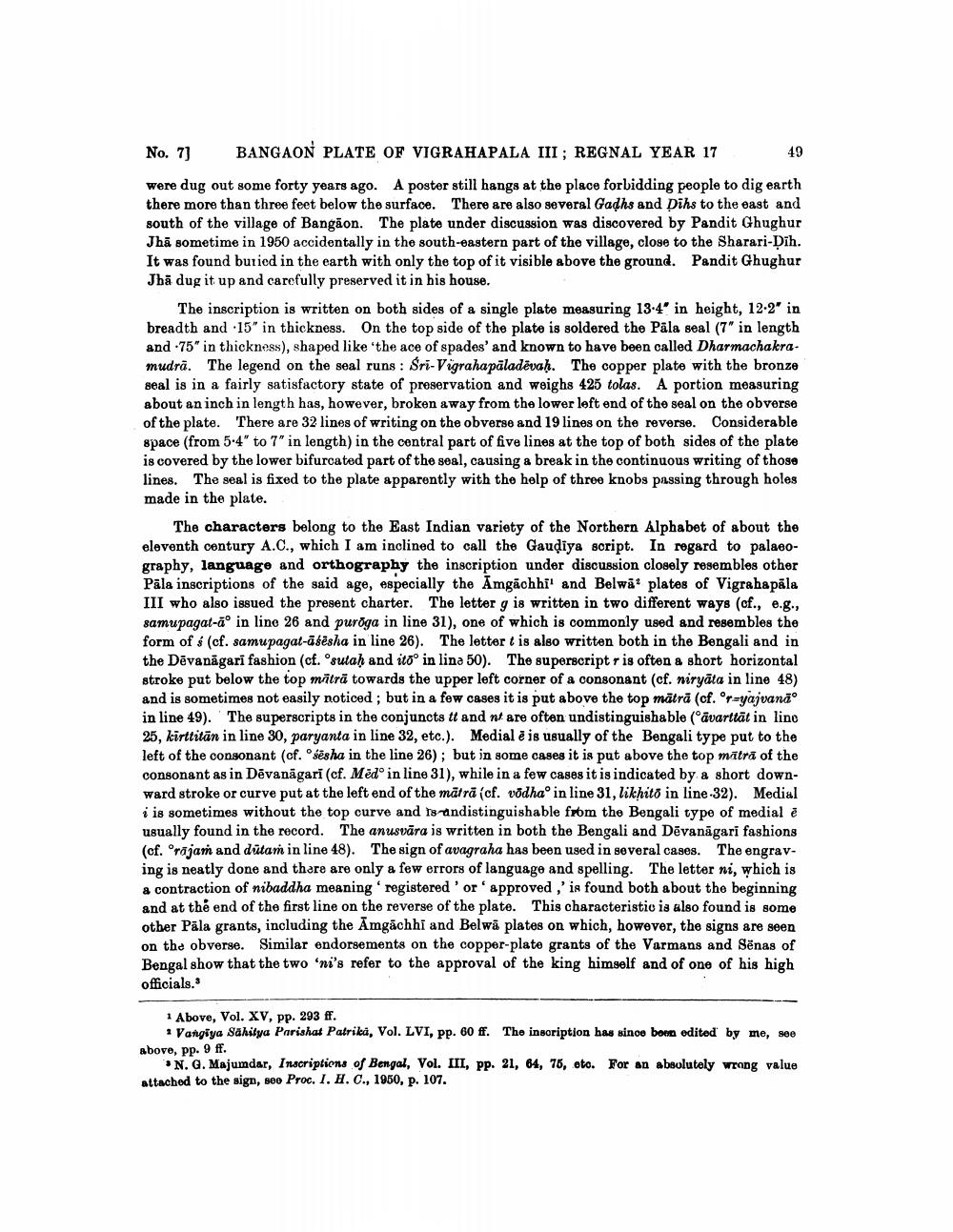________________
No. 7)
BANGAON PLATE OF VIGRAHAPALA III; REGNAL YEAR 17
49
were dug out some forty years ago. A poster still hangs at the place forbidding people to dig earth there more than three feet below the surface. There are also several Gadhs and Dihs to the east and south of the village of Bangaon. The plate under discussion was discovered by Pandit Ghughur Jhā sometime in 1950 accidentally in the south-eastern part of the village, close to the Sharari-Dih. It was found buried in the earth with only the top of it visible above the ground. Pandit Ghughur Jhā dug it up and carefully preserved it in his house.
The inscription is written on both sides of a single plate measuring 13-4" in height, 12.2" in breadth and 15" in thickness. On the top side of the plate is soldered the Pala seal (7" in length and .75" in thickness), shaped like 'the ace of spades' and known to have been called Dharmachakramudra. The legend on the seal runs: Sri-Vigraha pāladevah. The copper plate with the bronze seal is in a fairly satisfactory state of preservation and weighs 425 tolas. A portion measuring about an inch in length has, however, broken away from the lower left end of the seal on the obverse of the plate. There are 32 lines of writing on the obverse and 19 lines on the reverse. Considerable Space (from 5.4" to 7" in length) in the central part of five lines at the top of both sides of the plate is covered by the lower bifurcated part of the seal, causing a break in the continuous writing of those lines. The seal is fixed to the plate apparently with the help of three knobs passing through holes made in the plate.
The characters belong to the East Indian variety of the Northern Alphabet of about the eleventh century A.C., which I am inclined to call the Gaudiya script. In regard to palaeography, language and orthography the inscription under discussion closely resembles other Pala inscriptions of the said age, especially the Amgāchhi' and Belwa? plates of Vigrahapala III who also issued the present charter. The letter g is written in two different ways (cf., e.g., samu pagat-ão in line 26 and puroga in line 31), one of which is commonly used and resembles the form of 6 (cf. samupagat-asesha in line 26). The letter t is also written both in the Bengali and in the Dāvanāgari fashion (cf. sulah and ito in lina 50). The superscript r is often a short horizontal stroke put below the top mitrā towards the upper left corner of a consonant (cf. niryāta in line 48) and is sometimes not easily noticed ; but in a few cases it is put above the top matrā (cf.or=yajvanão in line 49). The superscripts in the conjuncts tt and nt are often undistinguishable (ävarttät in line 25, kirttitān in line 30, paryanta in line 32, etc.). Medial é is usually of the Bengali type put to the left of the consonant (cf. sēsha in the line 26); but in some cases it is put above the top mītrā of the consonant as in Dēvanagari (cf. Mēdo in line 31), while in a few cases it is indicated by a short downward stroke or curve put at the left end of the matrā (cf. võdhaoin line 31, likhito in line 32). Medial i is sometimes without the top curve and is andistinguishable from the Bengali type of medial e usually found in the record. The anusvāra is written in both the Bengali and Dēvanāgari fashions (cf. Rrājam and dutan in line 48). The sign of avagraha has been used in several cases. The engraving is neatly done and there are only a few errors of language and spelling. The letter ni, which is a contraction of nibaddha meaning 'registered' or ' approved ,' is found both about the beginning and at the end of the first line on the reverse of the plate. This characteristic is also found is some other Päla grants, including the Amgachhi and Belwā plates on which, however, the signs are seen on the obverse. Similar endorsements on the copper-plate grants of the Varmans and Sēnas of Bengal show that the two 'ni's refer to the approval of the king himself and of one of his high officials.
1 Above, Vol. XV, pp. 293 ff.
· Vangiya Sahitya Parishat Patrika, Vol. LVI, pp. 60 ff. The inscription has since bom edited by me, see above, pp. 9 ff.
N. G. Majumdar, Inscriptions of Bengal, Vol. III, pp. 21, 64, 76, oto. For an absolutely wrong value attached to the sign, seo Proc. I. H. C., 1950, p. 107.




